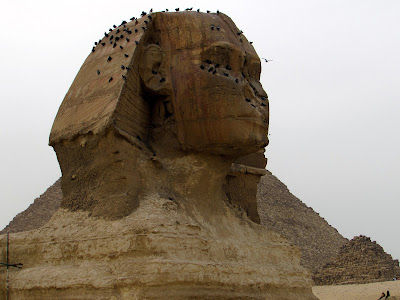If your way of visualizing the great pyramids has been, like mine, established partly by photographs and partly by Old Testament Hollywood movie-spectaculars like The Ten Commandments, then trust me when I tell you that your visualization doesn't come close to the real thing.
Seeing the pyramids didn't surprise me, consequently, because they look exactly like the dozens or maybe hundreds of photographs I have seen over the years.
But, for the record, standing before or beside them is awe inspiring. They are first of all huge, they are astonishing works of engineering and art, and they are unspeakably impressive.
And they speak to me, in a way that is hard to express, of the human cost of their construction. The labor required and the lives consumed -- as well as the obviously brilliant ingenuity -- is unimaginable.
The Great Pyramids rise up hundreds of feet from elevated ground on hard, sun baked, absolutely lifeless desert. Every sign of life lies down hill. As you walk closer, because one must approach on foot, the immensity of these structures makes itself felt. One feels a weight that is both grand and oppressive in a way that, again, does not feel overstated.
One hundred yards away, traders in traditional dress had lined up to offer various souvenirs. My understanding is that they are restricted to this area so that tourists are free to approach the pyramid without interference.
We did not ride camels, nor investigate the wares here, largely because when time is limited to absorb this moment by the Great Pyramids, that's what one needs to do. Let the moment sink in.
Looking up, the size and complexity of these "simple" structures becomes more apparent. They rise like mountains with perfectly regulated sides and angles. The fact that they were constructed by human labor, block by measured block, brought to this place from elsewhere, fitted together without mortar, and absolutely dedicated to a singular purpose leaves one virtually speechless.
From the Great Pyramids we drove downhill a short distance to view the famous Sphinx, a different experience altogether. The Sphinx cannot be approached very closely, and there is scaffolding for restoration work. And after the immense presence of the Pyramids, it feels almost small..
On the day we visited, birds had settled on the famous head and in the process tarnishing its dignity. All told, it does not look exactly like the photographs we have seen that enhance its majesty.
Still, I am glad to have seem it in person. After a few minutes we were back in the van weaving our way around the camels, to a shop where we could watch papyrus being made into paper. Yes, paper-making from papyrus is still a thing.
This young woman demonstrated the various stages of paper-making for us. Here, she is slicing a papyrus stem by hand into predetermined lengths, which will then be soaked for a number of hours in the bin to her left. Then the strips are laid out both horizontally and vertically in the desired size, the water is pressed out, and the paper set out to dry. It is the sugar in the papyrus itself that binds the dried strips together.
All the paintings in the shop depict traditional scenes. Like other ancient forms of paper, papyrus folds badly but rolls well -- a characteristic that I had not considered before. We had opportunity to see and/or purchase items in the shop before climbing back into the van. By this point it was late afternoon and time for lunch.
But our day of tourism was not over. We still had miles to go before we slept.









No comments:
Post a Comment